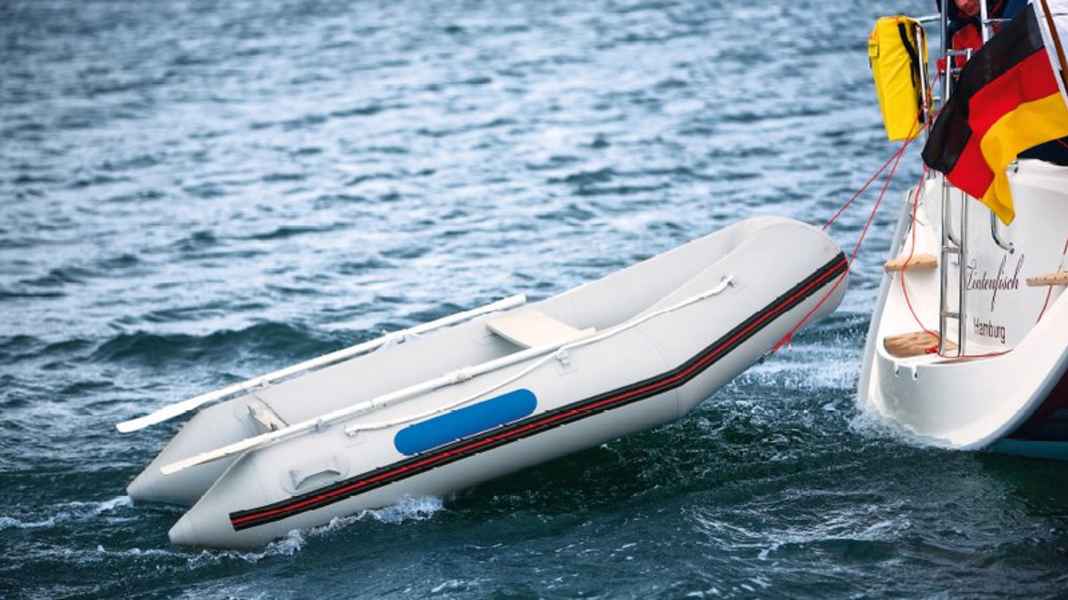
If you want to get ashore dry at the anchorage, you need a dinghy. In addition to its purely transport function, it also serves as a welcome plaything for the kids. As long as it bobs behind the boat, there are hardly any problems. But where to put it when the journey continues? The practical dinghy quickly becomes a stubborn and annoying accessory.
In this article:
- 1. stow the dinghy below deck
- 2. step by step to the plump tender
- 3. how to get the dinghy overboard
- 4. dry into the dinghy with balance
- 5 Only those who sit comfortably can make good progress with the dinghy
- 6. towing the dinghy correctly
- 7. transporting the dinghy practically on deck
- 8. fix the tender at the rear
- 9. how the engine gets to the dinghy
Sure, you can simply deflate an inflatable boat and stow it below deck. But first you have to get it back on deck, and then in the evening in the next bay the fun starts all over again: inflate it, heave it overboard and screw on the engine. This is why many skippers either leave their rubber tender in the back box or tow it behind the yacht throughout the summer. Neither is necessarily the best solution.
Of course, if you have davits, you're in the clear: two slings are attached, the dinghy is hauled tight and out of the way. But even without elaborate stern constructions, an inflatable boat can be stored on the transom of most yachts. Whether upright or transverse depends on the conditions on board. Another option would be to tie the tender to the foredeck - because the boat can also be stored where there is enough space to set it up. But where to put it in the harbour? After all, it not only blocks the way ashore, but also blocks the forward hatch.
If the tender is to be towed, the right line length is important. If the dinghy is set unfavourably, it will quickly turn into a towing anchor and unnecessarily slow down the painstakingly trimmed yacht. But it's not just when towing and stowing that you can make life easier for yourself; even lifting the dinghy on and off the boat is easier with a few tricks. Finally, practical use can also be made more comfortable, for example rowing, or how to ensure propulsion with just one oar.
Our sister magazine YACHT has compiled the best tips for handling a dinghy - this advice can also be applied to motorboats!
1. stow the dinghy below deck

Admittedly, inflatable boats have the smallest packing size compared to other types of dinghy, and modern boats usually have a spacious forecastle box. But after the first attempt to heave the dinghy out of the depths of the hull at the latest, every skipper thinks about alternatives and, if possible, ground-level storage options. Apart from the forecastle, only the saloon offers enough space below deck. Tied to the table, the bag can be stowed safely, but blocks the footwell so that children at most can sit comfortably.
Transporting the folded dinghy on deck, on the other hand, is almost classic. Depending on the shape of the superstructure and any lines routed above deck, the position at the very front is ideal for this. In this position, however, the dinghy is not only permanently exposed to the weather, but also usually obstructs the view forwards. To ensure that the bag does not slip when the boat is in position and in the event of a sea chop, solid fixing points such as jibs, handrails or deck eyes are required.
2. step by step to the plump tender
The order in which the chambers are inflated is almost irrelevant. However, it is advisable to start with the outer skin and to switch the hose frequently so that the chambers are filled evenly. Insert the floor, bench seat and inlay boards right at the start; with air floors, you can also wait until the dinghy is roughly in shape. Once the hoses are inflated, the floor is pressurised. Pump vigorously, even a person weighing 80 kilograms can hardly achieve more than a quarter of a bar. Then fill the keel. Like the hoses, it can withstand around 0.25 bar.
The best air pump
Unfortunately, the hassle of inflating is inherent to the inflatable boat. But it can be minimised by purchasing a double-stroke piston pump with as large a volume as possible. The foot pumps that usually come with the boat use a lot of energy for the unavoidable inflation and contraction of the bellows, which takes up about half of each stroke. The piston pump with its rigid walls completely eliminates this loss, and good models also pump air into the boat in both directions. This means far fewer working strokes and faster operational readiness. What's more, they can also extract the air for minimum packing size. Electric air pumps are even more convenient, but considerably more expensive.
3. how to get the dinghy overboard
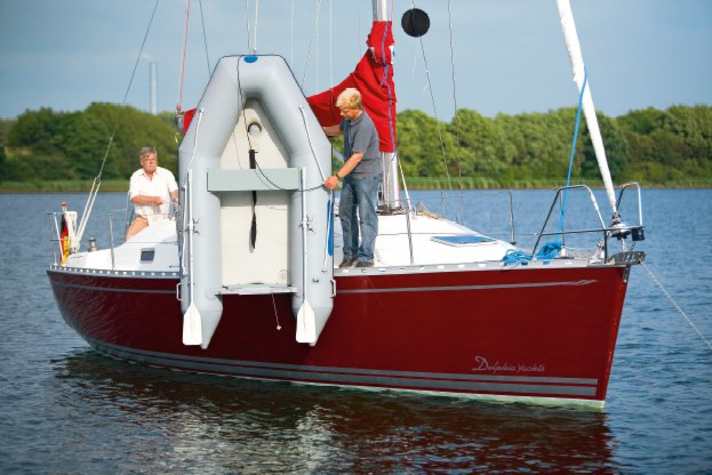
As soon as the dinghy is set up, it is painstakingly heaved over the railing. This is not only unnecessarily strenuous, as even a 2.30 metre dinghy weighs around 30 kilograms, but can also easily lead to material damage. On sailing yachts, a comfortable crane is always available with the rig.
The simplest solution: a free halyard that is shackled to the bow eye. The dinghy can now be lifted with the halyard winch until it swings freely over the railing. The foreship man only has to guide it slightly to the side. It is not a problem that it dips stern first when being lowered; the ends of the hose are usually buoyant enough to prevent water from sloshing over the transom.
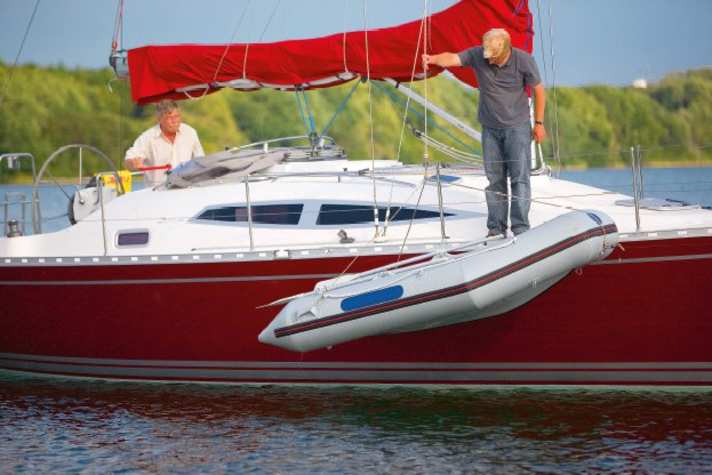
If the halyard is attached to the towing eyes instead of the bow eye, it can be released from the deck without having to twist. The three-point hitch on the bow and transom is particularly gentle. However, the dinghy should be hung slightly stern-heavy so that any water that has penetrated the stern runs off via the bilge pump when hauling up.
4. dry into the dinghy with balance
Inflatable boats have a stable floating position. Nevertheless, small dinghies should not be stepped on - if there is no second person in the boat, there is a risk of capsizing. This applies in particular to versions with a pronounced V-bottom. When boarding via the bow, these dinghies react very wobbly at first. It is much more comfortable to board alongside. In this case, too, the further amidships you go, the more stable the tender will be.
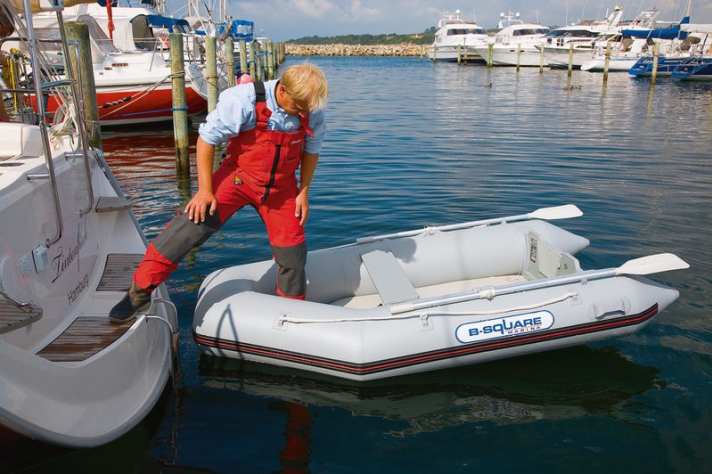
5 Only those who sit comfortably can make good progress with the dinghy
If the dinghy is to be moved without an outboard motor, rowing is the best solution. However, it gets cramped with just two people, because apart from a transverse bench, the dinghies, which are usually 2.20 to 2.60 metres long, generally have no seating.
There is not enough space to sit sideways on the tube. If the passenger sits down in the bow, the boat will list heavily and is almost impossible to manoeuvre. That leaves the transom. Padded with a hard cushion fender, it provides a comfortable seat and the trim is also right.
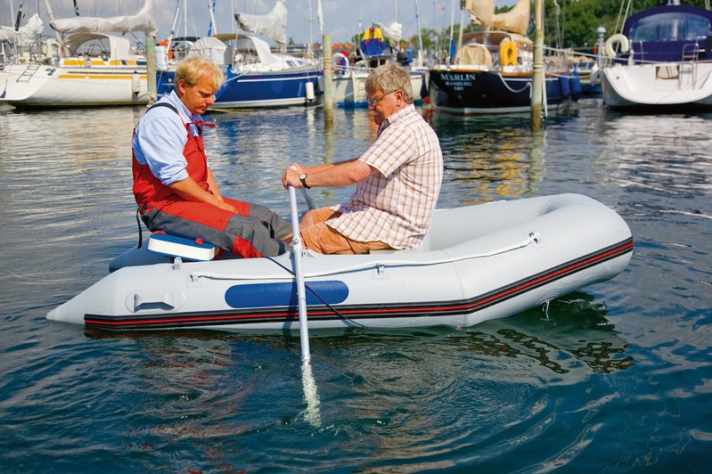
With smaller tenders, the crew and skipper quickly get into each other's arms and legs when rowing. The only thing to do then is to loosen the oars and paddle. However, this requires a well-coordinated crew, and although the entire crew provides propulsion in this way, the propulsion method is significantly less effective; longer distances are difficult to cover.
You can still find inflatable boats without a bench seat, especially among the particularly favourable offers. Even if you are on your own, rowing them can be a real pain as the oars are difficult to pull through while sitting on the floor. Inflatable rollers are available as accessories to replace the bench. However, these do not offer much more comfort than a well-inflated fender pressed between the tubes.
Tender with front-wheel drive
Even a single belt can generate a surprising amount of propulsion. This is done by kneeling in the bow. The movement of the paddle on the water surface describes a figure of eight and the blade is positioned according to the image sequence.
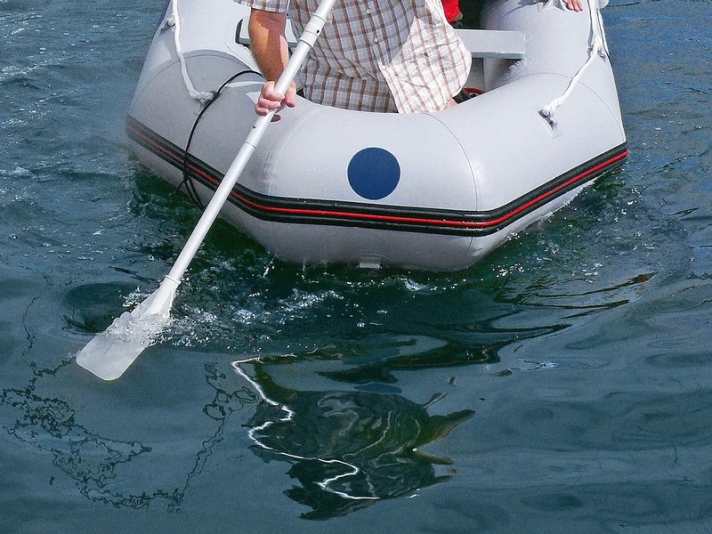
6. towing the dinghy correctly
The suggestion of towing the dinghy is met with massive resistance from many boaters: "That slows you down! That's true. But whether the dinghy noticeably slows down or quickly follows, swings from one side to the other or stays in the wake depends on skilful line management and a sensible choice of line length. And with more powerful motorboats, of course, it also depends on the speed being travelled.
Of course, it must generally be able to run at the speed set by the towing yacht - or the boat must adapt to the dinghy. Which for a dinghy always means planing. The procedure described here does not work with a pointed rig, for example a banana boat without an additional spoiler or trailing edge. The trailer should also be as light as possible and balanced or trimmed slightly forwards. This means: The motor must come off. And the bilge plug on, but that is probably clear. If you now adjust the towline so that your own stern sea pushes the boat in front of you, you will notice this as soon as you moor: There is hardly any pull on it. The optimum length depends on the speed.

7. transporting the dinghy practically on deck
In long pits, you often see dinghies permanently moored behind ships. However, this has various disadvantages: It not only complicates your own casting off manoeuvres, but sometimes also hinders your neighbours. There is a particularly high risk of damage if the tender protrudes beyond its own box (which is therefore undesirable in most harbours). Under the jetty is also not a good place: fluctuations in the water level can easily cause the inflatable boat to become jammed, chafe and even damage the jetty, even in areas that are actually tide-free. This could result in a hefty bill from the harbour master. However, a dinghy should not be constantly in the water because of the inevitable growth of vegetation. So the only space left is on deck or at the stern.
On typical boats, there is only enough space on deck at the front. Lying flat (keel up so that no water collects) and well lashed down, it is easy to sail. To clear the deck for harbour or anchor manoeuvres, you can then raise the boat with a halyard and position it between the superstructure and the lower shroud.
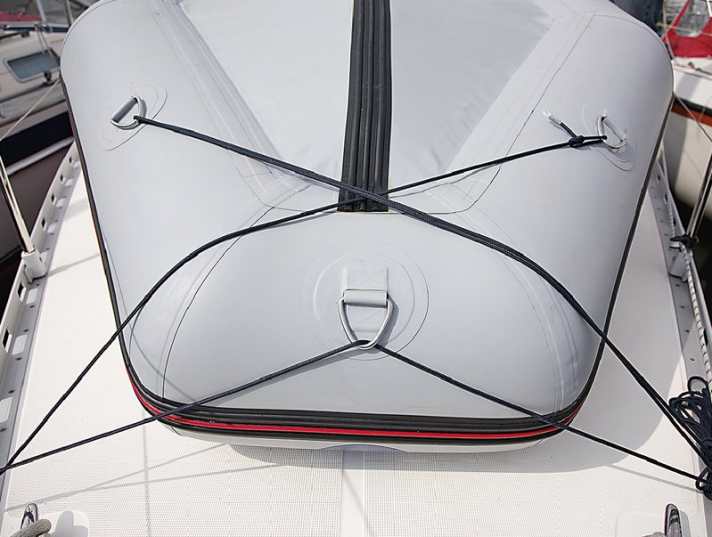
Beach in a dinghy?
Sand or stones between the air chambers and the floor will wear down any inflatable boat in the long term. It is impossible to prevent these foreign objects from getting on board. However, they can be easily washed out again: Position the boat so that water can drain directly over the transom, deflate and remove the floor, then rinse out the hull with a water hose or bailer. This takes less than five minutes. If you are skilful, rinse the sand outboard instead of on the deck of the yacht.
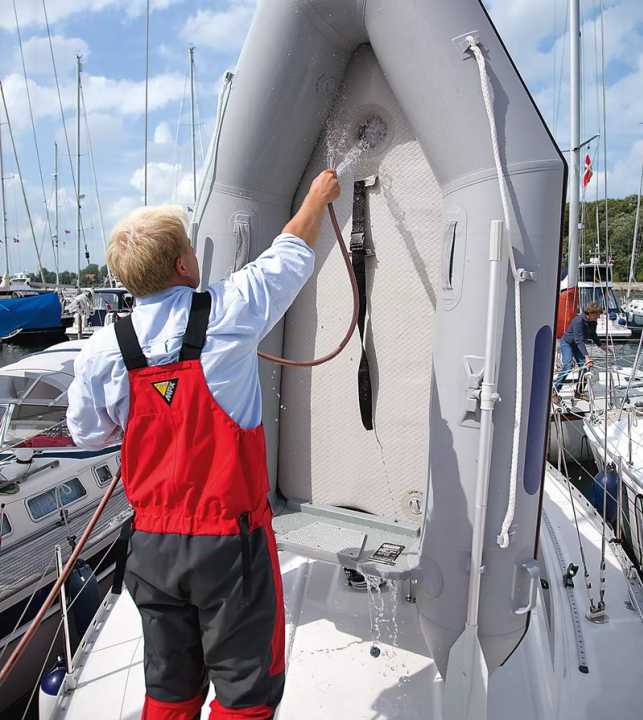
8. fix the tender at the rear
The dinghy is least disruptive at the transom, where it does not obstruct the view forwards or backwards. However, on most boats the bathing ladder is blocked so that it is no longer readily available for picking up people who have fallen overboard. For this reason, a tender attached to the stern should be easily detachable in an emergency. Without davits, only stowing on edge is possible due to the lack of attachment points, ideally standing upright. Although this looks totally unsportsmanlike, it prevents water from collecting inside and minimises the risk of getting caught on poles in the harbour. The boat must hang high enough so that it does not dive into the stern sea. One possible construction looks like this: The aft ends of the hose are stuck in bays that remain permanently attached to the boat, a line through the towing eyes secures the bow. When travelling at night, make sure that the stern lantern is fully visible.

9. how the engine gets to the dinghy
If you have a small, lightweight outboard motor and a yacht with a bathing platform, you're in luck: the transfer can be done by hand. But at 4 hp at the latest, the easy part is over, especially if the whole thing is to take place in a rough anchorage. For larger boats, it may be possible to create a crane construction on the superstructure. If the engine cannot be lifted easily and there are no davits on board, you will have to resort to cranes or similar devices in the harbour.
Where to put the Jockel?
Petrol outboards are best stowed at the railing: this prevents the stench in the ship and fuel spillage in the forecastle, and on many modern ships there would not even be enough space. Rule of thumb: As long as you can lift the engine on your own, the pushpit can withstand it. If the jockey wheel is to be lowered below deck, for example to prepare for heavy weather or to prevent theft, always empty the carburettor first and then drain any residual water from the cooling ducts. The head must always be higher than the shaft

